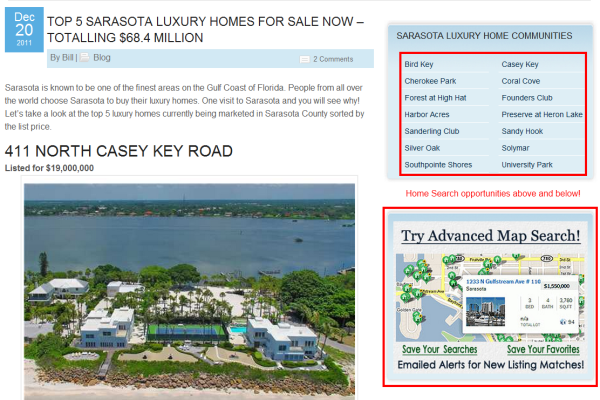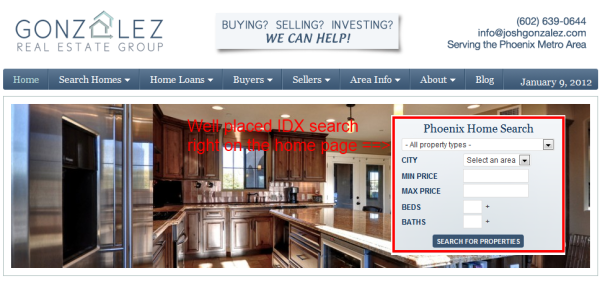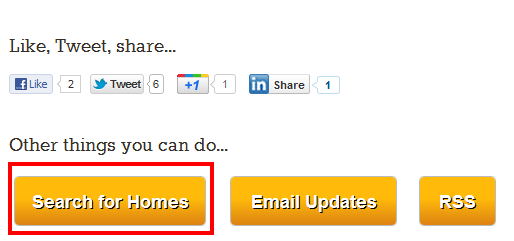4 Ways To Drive More Traffic To Your IDX Search Page
 Getting 1,000 hits to your real estate blog/website is great.
Getting 1,000 hits to your real estate blog/website is great.
But you know what would be even better, getting 1,000 hits on your IDX search page specifically.
Think about it this way… Where are you converting site visitors? On your home page? On a blog post?
Neither. Right?
No, you’re converting them on your IDX search page. That’s where they click to search for homes. That’s where they sign-up and register to get email alerts as new properties hit the market that match their criteria.
In fact, consumers care about searching for homes so much that you can force people to register (and convert them into leads) in order to use your IDX search tool. That’s why IDX visitors is a much more important KPI than overall site visitors.
4 Ways To Drive More Traffic To Your IDX Search Page:
1. Funnel all visitors, on any page, ultimately to an IDX search page.
This means that you should have Call To Actions to access your IDX search page placed within every post/page of your website. Here’s an excellent example from WeSellSarasota.com:

Notice the Call To Actions in the sidebar of the individual blog post. They both redirect the user to IDX search pages. One that shows various real estate by community and another that prompts the visitor to access the IDX search page where they’re are they encouraged to register for an account.
Now, take a look at your own website… Could you do a better job of funneling site visitors to your IDX search page?
2. Always provide a fast, generic search option.
The first thing consumers should see when they land on your website is a quick and easy way to access homes for sale. After all, that’s one of the primary reasons they’re visiting your website to begin with.
Here’s a great example by JoshGonzalez.com:

This home page is the perfect landing page. The header quickly communicates:
- Who the site belongs to (the Gonzalez Real Estate Group) and what area(s) they service (the Phoenix Metro Area). I don’t have to guess whether they cover my area, it’s spelled out for me right then and there.
- The type of clients they service – Buyers, Sellers, and Investors.
- Contact information (name, and email) are clearly visible on the upper right-hand side of the page.
- And last but certainly not least, there’s a quick IDX home search option right there on the page for me. I don’t have to guess and fumble my way through, I can just start searching for homes right then and there.
3. Remember, you can’t control where people will land.
…but you can influence what they do next.
So when you’re creating a blog post, or a page, think to yourself: What do I want readers to do next? Then, draft your Call To Actions accordingly. Here’s an example of a very subtle Call To Action embedded at the end of every blog post by PhoenixRealEstateGuy:

You can “share” this blog post through each of the various social networks. You can subscribe to receive future posts by email or RSS. Or, you can “click here” to search for homes.
4. Match widgets and Call To Actions to your market.
Here are examples of two separate community landing pages on WeSellSarasota.com…
First: Lido Key Homes for Sale

Notice how the two sidebar widgets show links to additional listings in each of the various neighborhoods in Lido Key and the widget below gives the site visitor access to listings in Lido Key by property type (Condos, Foreclosures, etc.).
Then, if we click on a different community to see Longboat Key Homes for Sale, we get:

Here, as in the example above, we can access listings in specific Longboat Key neighborhoods as well as access Longboat key real estate by property type.
In each of these examples, a custom sidebar was created in order to match the widgets and Calls To Action to the content on the page. This was done using the Genesis Simple Sidebars plugin. For non-Genesis users, this can also be achieved using the Widget Logic plugin for WordPress.
It’s a bit labor intensive to set up, but as you can see, it’s a very effective/targeted way to add specific calls to action to your unique landing pages.
Over to you…
What are YOU doing to drive more traffic to your IDX search pages? Will you be implementing any of the ideas listed above?
